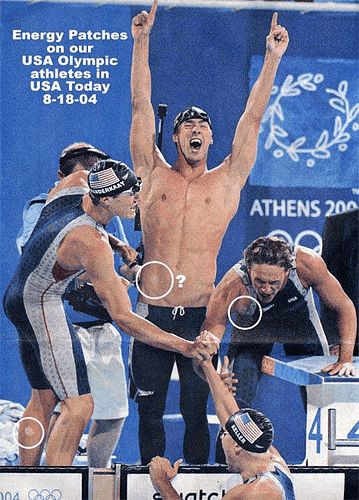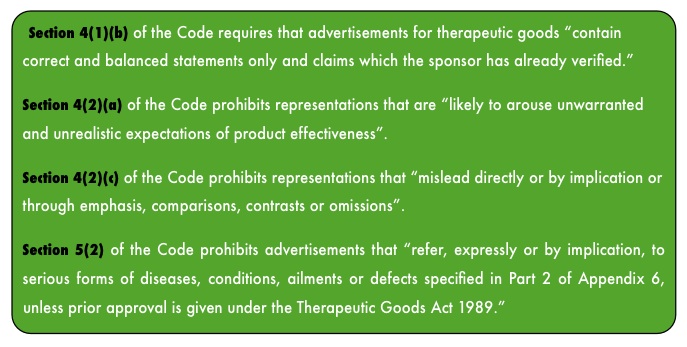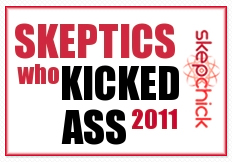I came across this complaint on the Complaints Resolution Panel website regarding an advertisement for LifeWave “magic” patches today.
(NB: I say magic because there is no known mechanism described in science to explain how these things apparently “work”, and I place work in inverted commas because these things have no effect above placebo, so technically they don’t work either).
A print advertisement and Australian website linking to the American version was found to breach the Advertising code sections 4(1)(b), 4(2)(a), 4(2)(c), 4(2)(d), 4(2)(i), 4(7), 5(2), 7(3) (see box below) following a complaint by an individual.
The website, classified as an advertisement by the regulatory body, promoted a range of LifeWave patches, namely the SP6 patch, Y-Age patch, Icewave patch, Energy Enhancer patch, and Silent Nights patch. For a description of the apparent functions of these patches (and an interesting exchange with a believer), you might be interested in reading my previous blog about Lifewave here.
This is an interesting case for consideration, since The Panel first had to decide who was responsible for the advertisements as the parent website (lifewave.com) is based in the US and the website which attracted the complaint is linked to it from Australia. They concluded that the website was in fact the responsibility of the Australian distributor, given that the url had been personalised (www.LifeWave.com/bodyinharmony).
Information on retailer websites is the responsibility of the website publisher
Publishers of websites should be aware that they are responsible for the material they publish, regardless of whether they have copied that material from product packaging or other websites. Some online retailers appear to be of the view that it is acceptable to duplicate information from such sources for the purposes of advertising products for sale, but take no responsibility for the publication of the information.
Reproduced from the Complaints Resolution Panel website.
The Panel found that the claims relating to the patches being effective in appetite control, craving control, weight loss, detoxification, antioxidant boost, anti-aging, skin repair, pain relief, relief of pain from injuries, relief of chronic pain, relief of migraines, relief of arthritis, enhancing energy, enhancing stamina, reducing fatigue, and promoting restful sleep, had not been verified, were misleading, and could not be substantiated by the advertiser, therefore constituted a breach of the code [Section 4(2)(a)].
In the report published on the website, the Panel stated that;
“…they were not satisfied that the material provided by the advertiser constituted even minimally persuasive evidence that the advertised products could have the therapeutic benefits claimed in the advertisements”.
In particular the Panel targeted testimonials published on the website. As part of the code, testimonials are required to be documented, not misleading and be regarded as plausible illustrations for the potential benefits of the product. The concluded that claims such as “wow 20 seconds my pain was gone” and “90 seconds lower back pain was gone”, were indeed not plausible and therefore breached the code (Section 4.7).

The Panel did not accept photos like these as sufficient evidence that Michael Phelps uses Lifewave patches. Funny that.
The website also made claims that the patches were used by the swimmer Michael Phelps and several AFL football players, but the advertiser was unable to provide evidence for this, apart from the following statement;
“(they had) been told by LifeWave staff in Australia who hold training sessions that Michael Phelps has used the patches and that a few of the AFL teams have begun using the patches” and “there are photos on the internet that show Michael Phelps with the patches on his body.”
Then panel deemed this insufficient evidence and therefore concluded that these claims breached the code.
In Australia it is prohibited to advertise products that claim to treat or cure serious diseases/ailments, such as cardiovascular disease. The Panel deemed that the Lifewave website breached this section of the code [5(2)], by including “research” information which referred to “heart rate variability enhancement through nanotechnology” and many other references to heart rate variability, “increase[ing] glutathione levels in the body”, and other references to health issues.
In a meeting held on April 16, 2009, The Panel ruled that the advertiser was to withdraw the advertisements from further publication; and withdraw any representations that the advertised products are safe, or that they have benefits in relation to appetite control, craving control, weight loss, detoxification, antioxidant boost, anti-aging, skin repair, pain relief, relief of pain from injuries, relief of chronic pain, relief of migraines, relief of arthritis, enhancing energy, enhancing stamina, reducing fatigue, or promoting restful sleep.
The Advertiser was given 14 days to comply with this ruling and was instructed to provide evidence to The Panel of this compliance.
Which apparently the advertiser decided did not entirely suit them, since you can still find the website, in it’s shiny misleading, code breaching glory.
Which leads me to question; who is responsible for enforcing these rulings? How is it that these people get a slap on the wrist, ignore the ruling and carry on their merry way, selling products for which there is no evidence of efficacy? There should be a process whereby I can easily and quickly alert the TGA to the non-compliance and there should be substantial penalties for non-compliance.
Until there is, then the TGA Complaints Resolution Panel is about a effective as an ashtray on a motor bike = useless.
Browse Timeline
- « Vaccines are part of a world wide plot to commit mass genocide. This is not a conspiracy.
- » The Australian Vaccination Network (AVN) to be investigated by the Health Care Complaints Commission






